Anusha Ravi Sood in The Print
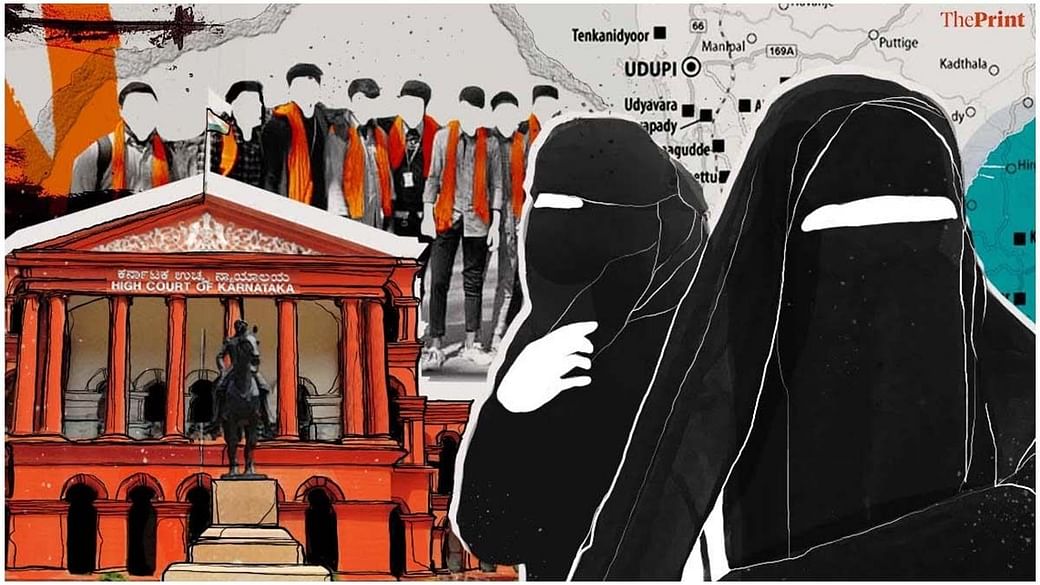
Udupi: Abdul Shukur took a sip of water and bit into a chikki (peanut bar) at 6:30pm Tuesday. It was his first meal after a day-long fast and he had come to offer prayers at the Jamia Masjid in Udupi, Karnataka. Shukur’s daughter, Muskaan Zainab, studies at the city’s Government Pre-University (PU) College and is one of several students who have petitioned the Karnataka High Court for the right to wear the hijab (headscarf) on campus.
“Our entire family fasted today since our petition was being heard in court. I will fast tomorrow too,” 46-year old Shukur, who runs a small business in Malpe, said.
The hijab row has been making headlines since January, but Shukur claimed the issue was triggered in October when viral photos showed Muslim girls at a protest organised by the Akhil Bharatiya Vidyarthi Parishad (ABVP, the RSS-affiliated students’ body).
The images in question were posted on the Facebook page of the Udupi ABVP on 30 October last year. They showed Muslim girls holding the ABVP flag as part of a protest demanding a probe into the alleged rape of a Manipal student. In the communally sensitive coastal belt of Karnataka, the pictures ignited a controversy.
“I was taken aback to see my daughter there… because she isn’t a member of ABVP,” Shukur said. Furthermore, Muskaan was not wearing her usual headscarf in the photo.
“I asked her why she wasn’t wearing a headscarf in the photo, and that is when she told me that the college doesn’t allow hijabs in classrooms,” he said. This came as a shock to Shukur, who decided to confront the college principal.
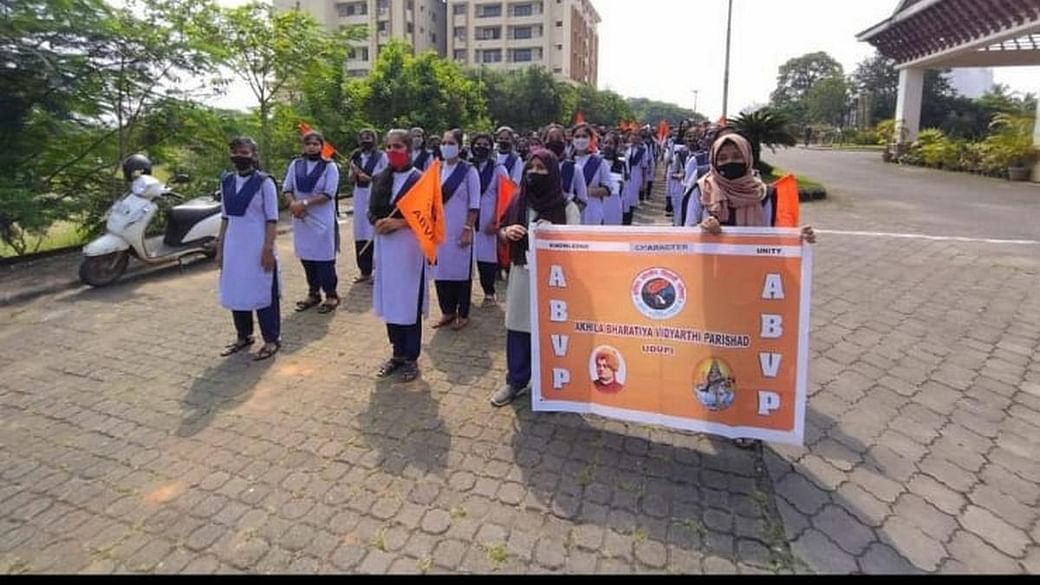
He was not the only one taking notice. According to an intel report submitted by the Udupi police to the state government, the Campus Front of India (CFI), which is the students’ wing of the Islamist outfit Popular Front of India (PFI), had approached parents with the offer to help take on the college management.
A source from the CFI who did not wish to be named told ThePrint that the ABVP protest incident had outraged the organisation. It therefore started encouraging Muslim women to refuse to join ABVP events and to fight for their right to wear hijabs in the classroom. The women’s parents also took these demands to the college.
“When I asked the principal why students were being sent to protest without consent and were not allowed to wear headscarves, he said it was a small issue,” Shukur said.
Rudre Gowda, principal of the college, rejected this allegation. “For years, students have been wearing hijabs to campus, but have been removing them during classes. These girls too were adhering to this, but since December, they started demanding that hijab should be allowed during classes too,” Gowda told ThePrint.
The matter quickly led to a standoff between the families of six Muslim students and the college management. The CFI also alleged that the college had, as retaliation, made details of the girls and their families public.
While there were attempts to negotiate an understanding between the students and the college authorities in Udupi, the row escalated rapidly — partly due to political organisations jumping on to the bandwagon and partly due to the wildfire effect of social media.
In January, the students petitioned the Karnataka High Court, by which time the issue was making headlines and had snowballed into communally charged conflicts in several Karnataka colleges.
Also Read: A timeline of how hijab row took centre stage in Karnataka politics and reached HC
Bruised egos and social media hype

Before the hijab issue reached the headlines, there were weeks of efforts to forge an understanding between the families and the college.
A senior leader of the Udupi District Muslim Okkoota — an umbrella organisation of mosques, jamaats, and Islamic organisations in Udupi — told ThePrint on the condition of anonymity that the body had tried its best to convince the families that it was acceptable to remove the hijab in class.
“We advised the girls to not make a big issue out of not wearing hijab inside classrooms. We even took them and their parents to religious clerics and explained that it was okay to remove hijabs in the classroom,” he said.
However, the students were “adamant”, he said, because they had received backing from the CFI, the campus affiliate of the PFI, an Islamist outfit that was set up in Kerala in 2006 and which the Bharatiya Janata Party (BJP) wants banned because of its allegedly radical tendencies.
“The CFI saw [the hijab conflict] as an opportunity to strengthen its support base,” the Muslim Okkoota leader said. In coastal Karnataka, he explained, the two main students’ bodies are the ABVP and CFI, while the Congress’s campus body, the National Students Union of India (NSUI), does not have a presence in local colleges.
When ThePrint spoke to CFI members in Udupi, they claimed that the organisation got involved only after students of the PU College approached them on 27 December, after their memorandums to the district commissioner and education department officials did not yield results. The students in question also told ThePrint that they were not members of the CFI. However, at least three parents are members of the PFI’s political wing, the Social Democratic Party of India (SDPI).
By the end of December, though, nobody was in the mood for a compromise, according to the Muslim Okkoota leader. He said that the Muslim women’s protest, and the social media traction it got, riled the College Development Committee (CDC), which is empowered by the government to take administrative decisions for public educational institutions.
“In December and January, the students’ protests started getting attention on social media and the press. They were shown standing outside the classroom and making notes since they were not allowed inside. This hurt the egos of the committee members,” he claimed, adding that the senior-most members of this body were members of the BJP and RSS. None of the 21 members in the CDC are from the Muslim community.
The matter had now become a “prestige issue” with the BJP and other Hindutva organisations on one side, and the PFI and its affiliates on the other, the Muslim Okkoota leader said.
BJP vs. PFI
What both Hindutva and Muslim organisations can agree on is that as videos from Udupi went viral, they sparked protests in other districts too. Throughout January and February, Karnataka saw several face-offs in colleges between some students in hijabs and others wielding saffron scarves. Each side holds the other responsible.
BJP leaders maintain that without “instigation” from the PFI, the protests wouldn’t have reached such a magnitude.
“Within two days of the girls’ protest in January outside their classrooms, thousands of social media posts were released. How is that possible without a pre-planned, strategised effort?” V. Sunil Kumar, Minister for Energy and Kannada & Culture, told ThePrint.
“When [Muslim students] started escalating the matter, naturally, students from the Hindu community retaliated — a matter of action and reaction,” Kumar, who is also the MLA from Karkala in Udupi district, added.

Other BJP ministers in the Basavaraj Bommai cabinet have also made similar allegations against the PFI. “Students are being instigated to protest for hijab. The role of the PFI and its student wing CFI will be probed thoroughly,” B.C. Nagesh, Karnataka Minister of Primary & Secondary Education, told reporters Tuesday.
The PFI has denied such allegations and has attempted to distance itself from the row.
“As an organisation, we are working for upliftment of marginalised communities. We are in no way involved in this row. Our student wing (CFI) is only trying to provide moral support to aggrieved students. Communal flareups only benefit the BJP,” Anis Ahmed, national general secretary of the PFI, told ThePrint.
The CFI has acknowledged that it was helping the Muslim women’s agitation in Udupi’s PU College, but denied having any political motives.
“We are a student organisation. We do not have any links with political parties. We are leading the students who are fighting for their rights. Muslim students have been harassed at that institute for years now. This is not a retort that erupted overnight,” Masood Manna, a committee member of CFI Udupi, told ThePrint.
Also Read: The right answer to the wrong hijab question is still a wrong answer
Why the PFI and its affiliates are so controversial
The PFI is the organisational successor of the Kerala-based National Development Front (NDF) and claims to fight for social justice for Muslims, particularly in the southern states of Kerala, Karnataka, and Tamil Nadu.
In 2010, the political wing of the PFI — the Social Democratic Party of India (SDPI) — was registered with the Election Commission. Since then, it has slowly been making inroads in the coastal Karnataka belt. It had one of its biggest triumphs in the December 2021 elections to 58 Urban Local Bodies (ULBs) in Karnataka, when it won six seats.
The CFI, meanwhile, is popular among Muslim students in three districts of coastal Karnataka — Udupi, Dakshin Kannada and Uttar Kannada. The CFI has actively eaten into the popularity of the Congress’s student wing, the NSUI, in the three districts.
However, the PFI has faced allegations of radicalism from the BJP. In April last year, the Union government told the Supreme Court that it was in the process of banning the PFI, claiming that many office-bearers had links with the now banned Student Islamic Movement of India (SIMI). Chargesheets have also been filed against members of PFI over their alleged involvement in various instances of unrest, which the organisation has dismisses as “baseless”.
Notably, some Muslim community leaders also have reservations about the PFI and its branches. The senior Muslim Okkoota leader who was quoted earlier alleged that the hijab protests seemed to be a ploy by the organisation’s political wing to mobilise support.
“All the Muslim girls use the same vocabulary… ‘fundamental rights’, ‘constitutional issue’, ‘hijab is intrinsic to Islam’. While they may have been wearing hijab for years, the words and phrases that are being publicly said are coming from one source,” the Muslim Okkuta leader claimed.
Allegations of “instigation”, however, have also been levelled against Hindutva organisations, which have started a counter-agitation involving saffron shawls and scarves, and an influx into colleges of ‘protesters’ who are not even students.
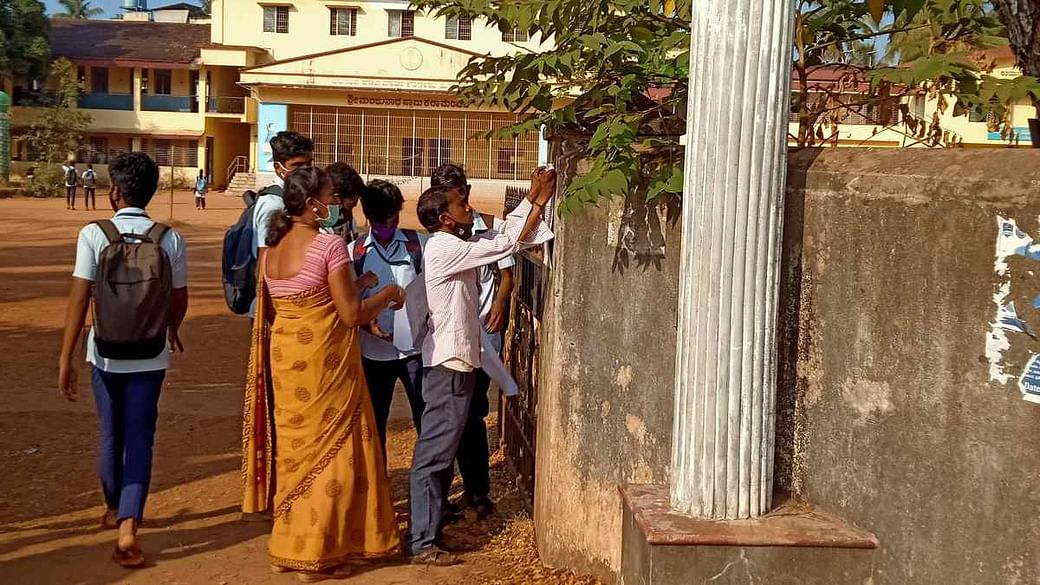
Doubling down on the hijab
“Perhaps one or two Muslim girls used to wear hijab to college but now the number has drastically increased. They are doing this to assert their religious identity,” Halady Srinivas Poojari, MLA for Kundapur, told ThePrint. He isn’t far off the mark, although there are varying interpretations of why exactly the women are doing so.
According to Abdul Aziz Udyavar, organising secretary of the Udupi District Muslim Okkoota, the fight over the right to wear the hijab has inspired other girls from the community to exercise their constitutionally guaranteed freedoms. “Just because I was not exercising my right before doesn’t mean I shouldn’t do it in the future,” Udyavar said.
Principals of at least three colleges in Kundapur told ThePrint that while some Muslim students had always worn the hijab to classes, the number had increased ever since the row took off in January.
“There is no explicit rule that bans hijab in the college, but there is no rule that permits it either,” Naveen Shetty, principal of R.N. Shetty College, said.
According to him, students who sought permission to wear hijabs earlier could usually do so “as long as it doesn’t cause trouble”. Now, Shetty said, it was causing trouble and so hijabs as well as saffron scarves were banned in the college. “The management decided to ban both explicitly until the time the high court order comes,” Shetty added.
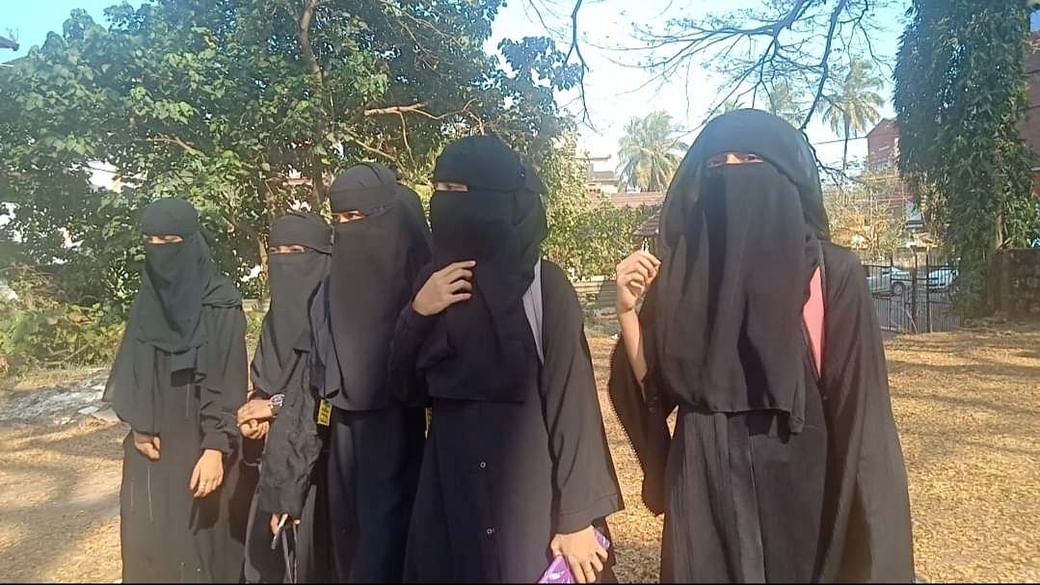
The Udupi PU College students who petitioned the court told ThePrint that they shouldn’t have to choose between their education and wearing a hijab, but said their stance has come at a cost to them.
Abdul Shukur, Muskaan’s father, said he was concerned for the family’s safety. Another student, A.H. Almas, told ThePrint about the hostility that she was encountering.
“When we started protesting, our details were leaked and unknown people follow us around,” she alleged, adding that members of the CFI were giving the women protection.
The Muslim Okkoota had until recently refrained from openly backing the hijab cause but has now reconsidered its decision. “When Muslim girls who are studying at co-ed colleges that have allowed hijab for years started getting targeted, we had to step in since it is injustice being meted out to them,” Ibrahim Sahib Kota, president of the Udupi Muslim Okkoota, said.
‘Senior VHP, Bajrang Dal, Hindu Jagaran Vedike leaders oversee saffron scarf distribution’
When ThePrint visited Mahatma Gandhi Memorial (MGM) College in Udupi, students wearing hijabs were engaged in a face-off with others who had donned saffron scarves and headgear. But, when ThePrint spoke to many of the Hindu protestors, they admitted they were no longer students of the college.
“I studied commerce here and passed out in the 2016-2017 academic year,” Sushanth sheepishly told ThePrint, identifying himself as an ABVP member. “For many years, [Muslim women students] have been wearing hijabs in classrooms but now since they are making a strong assertion of their religious right, should we not as Hindus assert our religious identity too?” he asked, insisting that the protesting Hindu students had all brought their own saffron scarves and shawls.
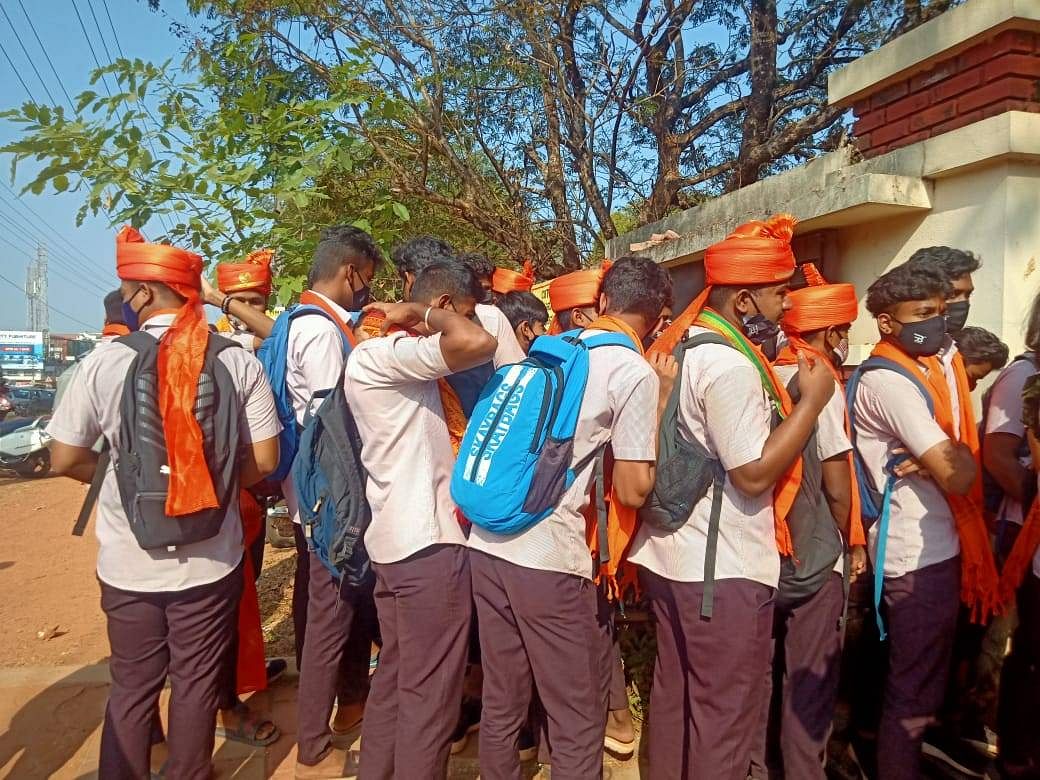
ThePrint, however, witnessed male protestors distributing saffron shawls to women students who had just arrived at the college. The scene was in line with a couple of videos that went viral this month: One showed students returning their saffron headgear to purported members of the Hindu Jagaran Vedike near their college, and another showed someone in an Innova car distributing saffron scarves to students at a college in Kodagu.
Another protestor, Akshat Pai, said he had graduated from the college in 2014, but was there in his capacity as a Hindu Jagaran Vedike leader. “We haven’t pressured the students into protesting. They are doing it on their own,” Akshat Pai said, as students in saffron accessories hovered around him and asked whether they should leave or stay.
A first-year B.Com. student, a Hindu woman, told ThePrint on the condition of anonymity that many of the protestors did not study at the college. “Why are outsiders coming and supplying saffron scarves to our collegemates?” she asked, adding that she had no problem with the hijab just as her Muslim friends had no objection to the bindi on her forehead.
Harshita, another Hindu student at MGM college, had a different viewpoint. She cited a 5 February government order proscribing clothes that “disturb public law and order” and said that if Muslim women could wear hijabs, Hindus could wear saffron scarves.
Prakash Kukkehalli, Mangaluru unit general secretary of the Hindu Jagaran Vedike, was observing the protest at MGM college from the other side of the road, with young men from the campus occasionally arriving to consult with him.
“We are not instigating students. We are only giving them moral support,” Kukkehalli told ThePrint.
According to him, the PFI, SDPI, and other Muslim organisations were provoking students for political benefit. “They have launched social media warfare to dent the image of India,” he said. “Today they will ask for hijab, tomorrow it will be Sharia law… a separate nation.”
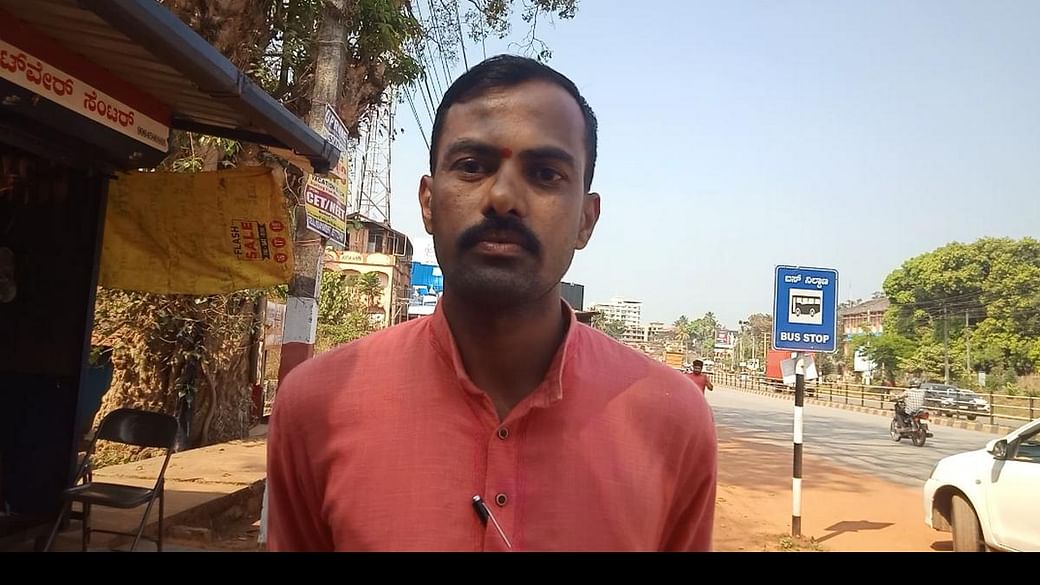
A former ABVP office-bearer, who did not want to be named, told ThePrint how the saffron scarf protest is orchestrated by Hindutva organisations.
“The saffron scarves are procured and distributed by office bearers. Senior leaders of the VHP, Bajrang Dal, Hindu Jagarana Vedike even visit protest sites to observe whom to groom as a leader and if anyone is straying away from discussed slogans or statements,” he said.
This former ABVP leader added that he did not believe in this kind of “communal activism”, whether from Hindus or Muslims, since it only harmed students’ prospects.
“Student activists should be fighting for better colleges, professional courses and employment — not this hijab or saffron scarf fight,” he said.
A deputy superintendent-rank police officer from Udupi told ThePrint that the police were aware of saffron scarves being handed out to students, but that this was not a crime. “Just before students arrive at their colleges, saffron scarves are being handed to them but that is not an offence,” the police officer said.
Over the past few days, though, the protests have taken a more violent turn. The police arrested 15 people in Shivamogga and Bagalkot districts Tuesday. Last week, police in Kundapur, Udupi, arrested two people, Abdul Majeed and Rajab, who were carrying knives near Kundapur Government PU College.
Communally sensitive belt of Karnataka
The three districts of coastal Karnataka — Dakshin Kannada, Uttar Kannada, and Udupi —are often counted among the more communally sensitive regions in India. All three districts have a sizeable population of Muslims as well as Christians.
“There are at least a hundred communal violence incidents in Udupi and Dakshin Kannada alone annually,” Suresh Bhat Bakrabail, an activist of the Karnataka Communal Harmony Forum (which keeps a track of communal violence incidents in coastal Karnataka) told ThePrint. In 2021, in a four-year high, there were more than 120 such incidents in these two districts alone.
Social activists attribute the frequent communal flare-ups in the region, which is frequently described as a “Hindutva laboratory“, largely to incitement from radical Hindu and Muslim organisations.